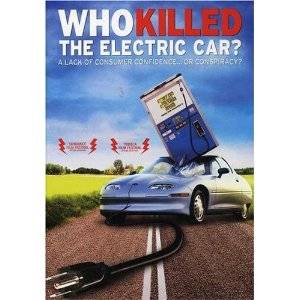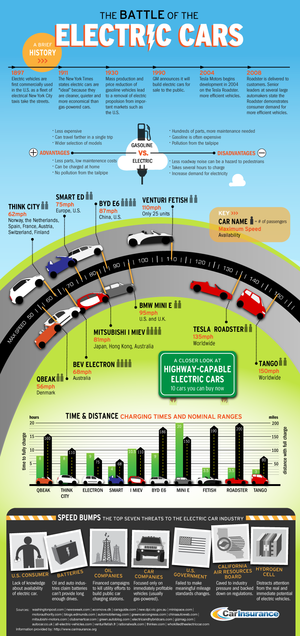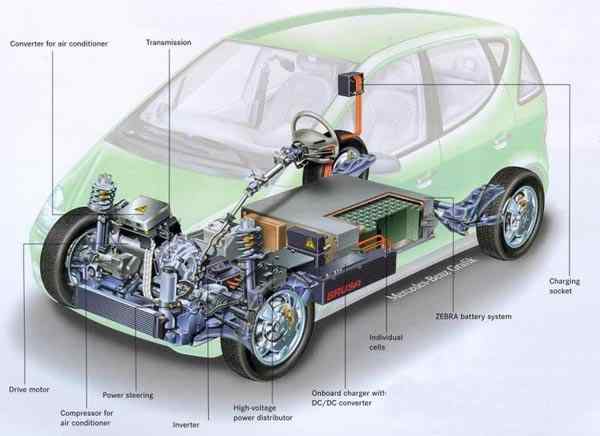Defining electric cars
Electric cars are cars powered by an electric motor, one or more controllers, and a large stockpile of batteries[1]. These vehicles plug into a source of electricity like a special recharging station (or -in the case of plug-in cars- in wall sockets) to recharge the battery. The main defining feature of an electric vehicle is that they have no gas engine. Unlike traditional plug-in electric vehicles (PEV’s), which rely only on batteries, hybrids have an additional source of power. Hybrid vehicles are “vehicles with internal combustion (IC) engines, also containing an electric motor and a small bank of batteries that assist the IC engine.[2] They can’t be plugged in for charging the battery, but instead rely on the conventional gasoline engine motor for charging the battery and/or a regenerative braking system. There are three types of electric vehicles that exist: battery-electric vehicles, conventional hybrid-electric vehicles, and plug-in hybrid vehicles.[3]
- They have less carbon dioxide emissions, which contributes to the depletion of the ozone layer. Even though some electric cars may use power that comes from coal the total amount of carbon dioxide emitted is less that that of gas-powered cars. Also they have no tailpipe which eliminates emissions (again this is as long as the energy source is renewable).
- They take no gasoline but rely on electricity from power grids and other forms of renewable energy such as windmills, solar panels, and so on.[4]
- Aids in reducing urban air pollution.[5]
- The batteries don’t contain as heavy metals as conventional cars and can be recycled.
- Electric vehicles require almost none of the maintenance of conventional cars like oil changes and emissions check. Electric vehicles can provide nearly 1 million mills of service before needing maintenance.[6]
- Noise pollution is reduced, especially in major cities. Electric vehicles have no muffler and there is no need for one because there is no engine, or ignition, so it has nothing to muffle. The cars are almost completely silent.
- Reduces the dependency on foreign oil. Purely electric vehicles takes no gasoline, but uses alternative energy sources to generate electricity.[7]
History of the electric cars

A locomotive was the first fully electrical vehicle created by Werner Von Siemens.[8] The first fully electric mode of transportation in America was also a rail operation in 1888 created by General Electric. By the year 1891 a man named William Morrison put an electric motor in a car. Electric cars were supposed to be the car of the future and got a lot of attention in the 1890’s and early 1900’s.[9] However due to a breakthrough in internal combustion engines, cars that used gas ruled the 1900’s. Now in the 21st century, hybrids and electric cars are making a comeback due to the push for green and high gas prices.
How they work

Conventional hybrid-electric cars
Hybrid Electric Vehicles or HEV's [10] use both gas and electricity in a dual-fuel system. Cars typically use a lot of gas when coming to a stop or picking up speed after a stop. The electric motor is used to eliminate the siphoning of gas at these particular times. The electric motor is used from when a car is idle until 30- 40 mph. Passed 40 miles, the other half of the hybrid system known as the internal combustion engine takes over. The hybrid gets its name from being able to use the electrical motor and the combustion engine. It also charges the battery by using the kinetic energy from braking and redirecting that energy back to the engine. An example of a hybrid would be the Toyota Prius.

Plug-in hybrid-electric cars
Plug-In Hybrid Electric Vehicles are similar to the hybrid. PEV's (Plug-In Hybrid Vehicles) are different from HEV's because they have a larger battery. The larger battery holds a longer charge making it possible to not use the internal combustion engine for a greater period of time.[11] As long as the car isn’t used passed the point of its all-electric range, the Plug-In Hybrid is able to not use any gas. One criticism that Plug-In Hybrid Electric Vehicles receive is about how long it takes for the battery to charge. Due to the fact that it has a high capacity battery, fully charging the battery takes a while. It’s designed to be charged at night when people are sleep. An example of Plug-In Hybrid Electric Vehicles is the Chevy Fusion.
Battery-electric cars
Battery Electric Vehicles are fully electric vehicles. BEV’s (Battery Electric Vehicles)[12] are in a class of their own when it comes to saving gas. Due to the fact that it’s 100% electric, it uses no gas. The problem with BEV’s is the distance you can travel is greatly affected by weather, load, and speed. Depending on the temperature, a car will have to use more energy warming up the car or keeping it cool, which depletes the battery faster. Depending on how much it has to carry, the load will affect how hard the battery has to work. Lastly, if you like to go fast, don’t expect to go far. Like most cars BEV’s can travel further and longer at a controlled comfortable speed. For BEV’s that speed could range depending on what type of car you have. An example of a Battery Electric Vehicle is the Nissan Leaf.
Sustainability
Electric cars are just one way to “go green.” There a many benefits to electric cars including lower maintenance and maintenance cost, not having to go to the pump and most importantly its overall impact on the environment. Electric cars (and vehicles) are classified as zero-emissions vehicles (ZEVs) meaning they produce zero emissions from the actually vehicle. The minor emissions that are released happening during the generation of electricity, but even these emissions can be eliminated depending on how the electricity is generated—if its generated from a renewable energy source such as wind, solar, or hydrogen. According to the [13] “electric vehicles create only 1 percent of the pollution generated from the cleanest gasoline vehicles.”
References
- ↑ [http://www.hybridcars.com/electric-car Elkectric car definition
- ↑ according to “Plug-in Hybrids, The Cars That Will Recharge America” by Sherry Boschert
- ↑ Wikipedia: Hybrid electric vehicle #Comparison of regular hybrids with petroleum and plug-in hybrid vehicles
- ↑ U.S. Department of Energy Argonne's Transportation technology Research Development Center
- ↑ Sperling, Daniel "Future Drive: Electric vehicles and Sustainable Transportation"
- ↑ “Plug-in Hybrids, The Cars That Will Recharge America” by Sherry Boschert
- ↑ Anderson, Curtis D., and Judy "Electric and Hybrid Cars: A History" 2nd Ed
- ↑ http://www.american-rails.com/electric-locomotives.html
- ↑ http://en.wikipedia.org/wiki/History_of_the_electric_vehicle
- ↑ http://www.transportation.anl.gov/phev/index.html
- ↑ http://www.transportation.anl.gov/phev/index.html
- ↑ http://www.afdc.energy.gov/afdc/vehicles/electric_basics_ev.html
- ↑ American Lung Association